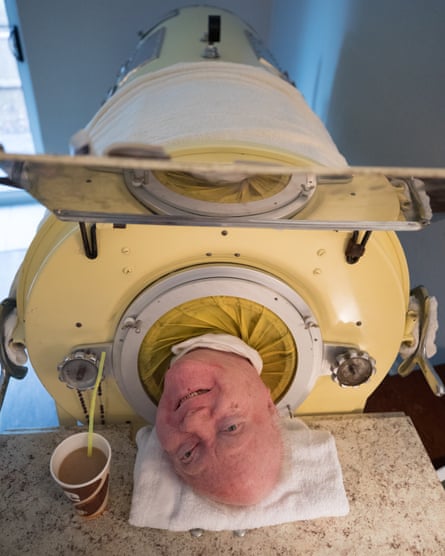Why Did Paul Alexander Live In An Iron Lung, what happened? Paul Alexander, known as “The Man in the Iron Lung,” was a remarkable individual who lived in an iron lung for over 70 years before his death.
Alexander managed to achieve significant milestones in his life, including graduating from high school at the age of 21 without attending classes, being accepted into the University of Texas at Austin to study law, and becoming a published author. He also practiced law in Dallas and Fort Worth, using a modified wheelchair to attend courtroom sessions.
As he grew older, Alexander faced additional health challenges. He had a respiratory infection and experienced pain in his legs every time they moved. These health problems, combined with his reliance on the iron lung for breathing, made his condition more complex and challenging to manage.
Despite his challenge/s, he continued to share his story and inspire others through his social media presence. His passing at the age of 78 was a significant loss, but his legacy lives on through the inspiration he provided to countless individuals.
Why Did Paul Alexander Live In An Iron Lung?
Paul Alexander lived in an iron lung for over 70 years due to contracting polio at the age of six in 1952. Polio is a viral infection that attacks the motor neurons in the spinal cord, disrupting communication between the central nervous system and the muscles, eventually making them too weak to allow a person to breathe on their own 5. This left Alexander paralyzed from the neck down, and he was placed in an iron lung, a respirator that works a person’s diaphragm, to assist with his breathing.
The iron lung, invented in 1928 by Philip Drinker and Louis Shaw, was designed to help patients with severe respiratory issues by creating a negative pressure that forced the lungs to expand and take in air. When the air was let back in, the same process in reverse made the lungs deflate. This mechanism was a lifesaver for thousands of children who would have died without it, as it allowed them to breathe when their muscles were too weak.
:max_bytes(150000):strip_icc():focal(749x407:751x409)/paul-alexander-iron-lung-031324-1-7b80ed7e7170440082f70a41b73650e4.jpg)
Despite the development of more invasive but much smaller positive-pressure ventilators in the 1950s, which were intended for short-term use, Alexander continued to live in his iron lung. He was one of the last people in the world still using an iron lung, and his story is a testament to human resilience and determination. Over time, Alexander learned to breathe on his own for short periods of time, a technique known as “frog breathing” or “glossopharyngeal breathing,” which involved trapping air in the mouth and throat cavity by flattening the tongue and opening the throat, pushing the air down past the vocal cords and into the lungs.
Alexander’s iron lung, referred to as his “old iron horse,” was a sturdy miniature submarine-like device that weighed almost 300kg. It was designed to last, even if no one thought the people in them would. The iron lung became emblematic of the devastating effects of polio, with only the sickest patients ending up in one. If they survived, a lifetime of disability was likely to follow.
Despite the advances in medicine that made iron lungs obsolete by the 1960s, replaced by ventilators, Alexander chose to continue living in his iron lung because he was used to it. He was recognized by Guinness World Records as the person who lived the longest in an iron lung 4. Alexander’s story is not just about survival but also about overcoming the limitations imposed by his condition to achieve significant milestones in his life, including graduating from high school, earning a law degree, practicing law, and publishing a memoir.
How Did Paul Alexander Pass Away? Death cause Revealed
Paul Alexander, known as “Polio Paul” and “The Man in the Iron Lung,” passed away peacefull on March 11, 2024, at the age of 78 in the presence of his brother,’ German newspaper Süddeutsche Zeitung reports.
His cause of death was a COVID-19 infection 123. Alexander had contracted COVID-19, which was particularly dangerous for him due to his condition. Despite being rushed to the emergency room and having an iron lung available at the hospital, Alexander’s health continued to deteriorate. He was weak, experienced confusion, and struggled with eating and hydration.
COVID-19, caused by the SARS-CoV-2 virus, posed a significant risk to Alexander, especially considering his long-term reliance on an iron lung for breathing. The infection likely compromised his immune system, making him more susceptible to severe complications. His condition was further complicated by his existing respiratory infection and leg pain, which he had been battling for some time.
Alexander’s passing was a tragic end to a remarkable life story. Despite his physical limitations, he achieved remarkable feats, including attending college, becoming a lawyer, and publishing his memoir. His story served as an inspiration to millions worldwide, highlighting the human spirit’s ability to overcome significant challenges.
What Is An Iron Lung and How Does It Work?
An iron lung is a medical device that was developed in 1927 and first used in a clinical setting in 1928 by Philip Drinker and Louis Agassiz Shaw at the Harvard School of Public Health. It was invented to help patients with severe respiratory issues, particularly those suffering from polio, by providing a method of artificial respiration.
The iron lung works through a process known as External Negative Pressure Ventilation (ENPV). It consists of an airtight chamber, typically made of steel, into which a patient is placed. The patient’s head remains outside the chamber, and a rubber collar keeps the enclosure sealed.

The device is powered by an electric motor and air pumps, which were initially sourced from vacuum cleaners. The respiration chamber functions by creating a negative pressure within the chamber. When air is sucked out of the chamber, the patient’s chest expands, filling the lungs with oxygen, even when the patient’s muscles are unable to do so. Conversely, when air is allowed back into the chamber, the lungs deflate, allowing the patient to exhale. This cycle of suction and re-inflation is what keeps the patient alive by ensuring they receive oxygen.
The iron lung was a lifesaving invention for thousands of polio victims, as it allowed them to breathe when their muscles were too weak to do so. It was a significant advancement in medical technology at the time, providing a means to support patients who were otherwise unable to breathe on their own. The device was large, cumbersome, and expensive, but its impact on saving lives was profound, especially during the polio epidemics of the mid-20th century.
Over time, the iron lung was replaced by more advanced ventilators that used Positive Pressure Ventilation (PPV), where air is pushed directly into a patient’s lungs through a tube. This evolution in medical technology reflects the ongoing improvements in life support systems, allowing for more effective and less invasive methods of respiratory support.
What Type Of Iron Lung Was Paul Alexander Using?
Paul Alexander was using a type of iron lung that was designed to assist with breathing for individuals who were unable to do so on their own, such as those with severe respiratory issues or paralysis from the neck down, as was the case with Alexander due to polio. The iron lung he used was a respirator that worked a person’s diaphragm, allowing for artificial respiration. This device was crucial for Alexander’s survival and quality of life, as it enabled him to breathe when his muscles were too weak to do so 2.
The iron lung Alexander used was likely a modified version of the original design, adapted to his specific needs and lifestyle. It was described as being in his home, indicating a level of customization or adaptation that allowed him to live a relatively normal life despite his condition. The iron lung was a significant part of his daily routine, providing him with the necessary support for breathing 12.
Despite the challenges and limitations imposed by his condition, Alexander managed to achieve significant milestones in his life, including graduating from high school at the age of 21 without attending classes, being accepted into the University of Texas at Austin to study law, and becoming a published author. His story is a testament to human resilience and determination, highlighting the potential for individuals with severe disabilities to lead meaningful lives.
ALSO READ: “BBC Scotland Presenter Nick Sheridan’s Final Farewell in Ireland”
Copyright © 2024 newsypeople.com All rights reserved. The information contained in newsypeople.com may not be published, broadcast, rewritten, or redistributed without the prior written authority of newsypeople.com



